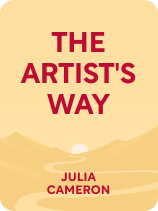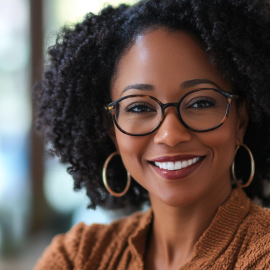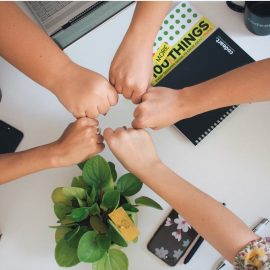

This article is an excerpt from the Shortform book guide to "The Artist's Way" by Julia Cameron. Shortform has the world's best summaries and analyses of books you should be reading.
Like this article? Sign up for a free trial here.
How comfortable are you with writing imperfectly—even journaling a “brain dump”? How in touch are you with your inner artist?
Many people feel it’s impossible to reach their creative potential—often because they struggle to find inspiration or experience creative blocks. Luckily, The Artist’s Way by Julia Cameron says that overcoming these obstacles and maximizing your creative potential is possible, and anyone can do it.
Continue reading for an overview of The Artist’s Way: A Spiritual Path to Higher Creativity.
Overview of The Artist’s Way by Julia Cameron
The Artist’s Way by Julia Cameron asserts that creativity is a spiritual force that everyone has access to. However, to channel this force into your art, you must first learn how to tap into it. The Artist’s Way: A Spiritual Path to Higher Creativity is Cameron’s 12-week program on accessing this creative force and using it to maximize your creativity and achieve your artistic destiny.
Cameron is a teacher, artist, poet, playwright, filmmaker, composer, and journalist. The publication of The Artist’s Way in 1992 marked a turning point in her career, giving her international recognition as a “creativity guru” and an expert on creative unblocking. Cameron’s teachings are based on her experiences of overcoming creative blocks like alcoholism and self-doubt and maximizing her creativity through spirituality. In 2022, Cameron published Seeking Wisdom—a follow-up to The Artist’s Way—that condenses her 12-week program into six weeks and focuses more closely on the role of spirituality and divinity in creativity.
We’ve organized Cameron’s 12-week program into two parts. In Part 1, we’ll discuss how to access the creative force by forming an intimate connection with yourself. In Part 2, we’ll explain how to foster a positive mindset conducive to creating art and resisting forms of negativity that block your creativity.
Part 1: Connect to Your Inner Artist
Cameron argues that human beings are creative by nature and that there’s a divine creative force that flows through all of us. This creative force is Cameron’s concept of “God.” She elaborates that you’re not required to call this force “God” or to associate it or yourself with any religion; however, to maximize your creative potential and attain your artistic destiny, you must believe in and learn how to tap into this force so it can flow through you and into your art. (Cameron refers to “art” as anything you use creativity to produce—art could be poetry, painting, philosophy, coding, developing new chemical compounds, and so on.)
The first step in tapping into the creative force, Cameron explains, is gaining an intimate connection to your inner artist—your deeper creative self that contains your seemingly crazy ideas, raw emotions, dreams, desires, and so on. This inner artist is a conduit for the creative force. The more intimate you are with this self, the more creative and artistically guided you’ll be.
We’ll discuss Cameron’s advice for uncovering and connecting to your inner artist.
Step #1: Write Morning Pages
One of Cameron’s primary methods for reaching your inner artist is to write morning pages—three full pages written every morning right after waking up. These pages can be about anything—last night’s dreams, your plans for the day, or things you’re excited or worried about. Don’t worry about making these coherent or well-written—just consider them a “brain dump.”
Cameron explains that morning pages help you connect with your inner artist in numerous ways. First, they clear your head of negative thoughts, concerns, and extraneous information that impact your mood or focus during the day. Worrying and overthinking often block out your less logical but more creative inner artist, so clearing this clutter right after waking up makes it easier to hear the voice of your inner artist throughout the day.
Further, Cameron argues that brain dumping through morning pages often uncovers hidden yet meaningful feelings and ideas that may otherwise remain unsurfaced. For example, you might recognize a pattern in your life that will inspire your art. Or, you may realize you’re deeply unhappy about an ongoing situation that must change to improve your well-being.
Step #2: Go on Solo Adventures
Cameron recommends taking yourself on at least one fun solo adventure (or “artist date”) a week. For example, you can visit a new place, take yourself to lunch at a cool restaurant, or paint in the park. These solo excursions are the perfect opportunity for you to gain inspiration and reflect on some of the deeper thoughts, feelings, and ideas you may have uncovered in your morning pages.
Further, Cameron explains that solitude is crucial to connect with your inner artist—this is the time when your creative self recharges. Without time alone, you’ll grow farther from your inner artist and, according to Cameron, become disgruntled with yourself and others.
Step #3: Uncover the Lost Parts of Your Inner Artist
Cameron explains that many elements of your inner artist—ideas, desires, dreams—often get killed off by your self-doubt and the doubts of friends, family, and society. However, these suppressed components are often the springboard for reaching your artistic destiny, or in other words, creating the art that you were destined to create.
To reacquaint yourself with the lost parts of your inner artist, Cameron recommends first reflecting on your childhood dreams and desires. Then, reflect on any of your recent or current dreams, desires, or ideas that you’ve convinced yourself not to explore—for money reasons, time reasons, practicality reasons, and so on.
For example, maybe you were interested in video production as a child but didn’t pursue it because you were told it doesn’t make good money—explore it now. Or, maybe you want to write a poetry book but think you’re not good enough—start now.
Step #4: Understand Your Inner Artist’s Emotions and Intuition
Cameron explains that, as you grow closer to your inner artist, you’ll experience a stronger sense of emotion and intuition. This can be overwhelming; therefore, you must understand and interpret these experiences to channel them into creativity and art.
According to Cameron, anger is the most common emotional experience that you must interpret and channel. She explains that anger indicates your likes, dislikes, and desires and signifies that you must take action. For example, let’s say you’re angry that your roommate moved your in-progress painting onto the floor so she could use your desk. Your anger is telling you that you need to speak up about your boundaries—tell your roommate not to touch your things without asking you.
Cameron adds that as you get closer to your inner artist and your creative intuition strengthens, experiences of synchronicity will begin to occur more frequently. Synchronicity is an instance where things seem to fall perfectly into place, external factors align in your favor, or meaningful patterns emerge. Cameron believes that these experiences are a form of divine intervention—some higher force is providing you with opportunities and hints that will progress you toward your artistic destiny. For example, perhaps you’ve been wanting to start dancing and end up meeting a dance instructor at the shop. Or you keep hearing about and seeing copies of a certain book about sculpting—maybe you’re meant to read it.
When these instances happen, Cameron says you must take advantage of them and trust your intuition. Many people convince themselves that synchronicities are coincidences, or that they’re unworthy of taking advantage of these synchronicities (they’ll fail or let themselves down in some way). Fight this urge, trust your intuition, follow the path that’s being opened for you, and Cameron says that you’ll end up exactly where you need to be.
Step #5: Engage With Your Inner Artist in Small Ways
Cameron recommends finding small ways to spark your creativity and engage with your inner artist that you can integrate into your daily life. One of the best ways to do so, she explains, is through movement—for example, doing yoga or going for a stroll. According to Cameron, moving your body gives you a break from hyper fixating on your thoughts by bringing your attention to the external environment. When you stop actively thinking and let your mind wander, you give more control to your inner artist. This helps you become more in tune with your feelings and makes you more likely to notice beauty and synchronicities around you.
Part 2: Foster a Positive Mindset
Cameron explains that many people struggle to maximize their creativity and reach their artistic potential because they engage in forms of negativity that block their connection to the creative force—for example, negative people, self-doubt, and perfectionism. To maximize your connection to the creative force and achieve your artistic destiny, you must remove these blocks and foster a mindset of positivity, abundance, and faith instead. We’ll discuss Cameron’s advice for doing so.
Step #1: Foster a Sense of Positive Belief
Cameron argues that belief is a cornerstone in maximizing your creative potential and achieving your artistic destiny. Belief encompasses a belief in your abilities and potential, as well as a conviction that you’re deserving of your dreams and desires, the universe is conspiring in your favor, and the universe will provide what you need when you need it.
According to Cameron, fostering this sense of belief is important for a few reasons. First, belief deepens your connection to the creative force, which naturally increases your creativity. Second, belief gives you the confidence to take strides toward your goals. And, finally—because taking strides toward your goals will result in synchronicities—the universe will reflect your efforts by providing opportunities that propel you toward your artistic destiny.
Cameron gives a few tips to foster belief.
Tip #1: Trust the Process
Cameron explains that impatience and fear of uncertainty often lead people to prematurely pursue half-baked ideas or half-hearted projects. She elaborates that truly great ideas take time to gestate—if you force them into fruition prematurely, you’ll sabotage their potential. As such, you must trust yourself and the universe—when it’s time to execute on an idea, you’ll know. Take things step by step and follow your intuition.
Tip #2: Embrace and Detach
Cameron explains that elements like money and luck come and go. Attachment to these things leads to dependence and diminishes your sense of belief. Instead, embrace life’s ebbs and flows—be grateful for gains and resilient to losses, and trust that you’ll receive what’s needed when necessary. Don’t make decisions solely based on gaining things like wealth or recognition. Instead, trust your intuition and prioritize personal happiness—for example, accept a lower-paying job or wear an “ugly sweater,” irrespective of others’ perceptions, because they bring you joy.
Tip #3: Nourish Yourself
Cameron explains that self-care is crucial for maintaining a positive mindset, which by default increases your sense of belief. If you feel emotionally neglected, restricted, or ill, or if you aren’t taking care of your physical health, you’ll struggle to maintain a positive outlook. As such, Cameron emphasizes the importance of nourishing yourself.
Eat well, and take care of your body, Cameron advises. Listen to your emotions and release them—for example, if you’re sad about a missed opportunity, allow yourself to be sad, forgive yourself, and move on. Treat rather than restrict yourself—buy the candle you’ve been eyeing or have a piece of cake once in a while.
Step #2: Overcome Negative Thoughts and Behaviors
The second step in fostering an artist’s mindset is overcoming negative thoughts and behaviors that block your connection to the creative force. Cameron discusses three major blocks that prevent people from reaching their artistic destiny: perfectionism, limiting beliefs, and addictions. Let’s talk about these blocks and how to overcome them.
Block #1: Perfectionism
Cameron explains that many artists hold themselves back due to their obsession with perfection. Perfectionism blocks people from achieving their artistic destiny, first and foremost, because art is subjective—“perfect” art simply doesn’t exist. As such, striving for perfection will simply cause you to hyperfixate on unimportant details and prevent you from finishing projects. Further, the fear of failing to achieve perfection prevents many artists from even taking a first step toward their goals.
Cameron makes two recommendations for overcoming perfectionism. First, rather than striving for perfection, identify and strive for “good enough.” Second, allow yourself to create bad art. Cameron elaborates that no artist creates the ideal final product on their first try—before you create good art, you have to be willing to create bad art.
Block #2: Limiting Beliefs
Cameron says many artists block themselves with limiting beliefs—for example, they believe they’re not good enough or are too old, or they focus on regrets or future uncertainties. Whenever you find an excuse or reason for not taking action to achieve your artistic destiny, you’re engaging in some form of limiting belief. To help you overcome this block, Cameron makes a few recommendations.
First, Cameron advises that you ground yourself—pay attention to the beauty of your surroundings, the present moment, and what you can be grateful for. Grounding yourself will help you avoid giving attention to thoughts about the past or future that may discourage you from taking positive action.
Second, writes Cameron, seek out information that disproves your limiting belief. For example, if you think only rich people can produce the type of art you want to focus on, look up stories about successful artists who struggled financially.
Finally, Cameron recommends using positive affirmations to override your limiting beliefs. To do so, notice when a limiting belief crops up, create an opposing positive affirmation, and write it down 10 times in a row. For example, if you want to start a mural but notice your mind telling you “you’ll never finish, you’re not dedicated enough,” form a positive affirmation like “I’m a passionate artist, and I’m dedicated to completing a mural that will inspire others.”
Block #3: Addiction
Cameron explains that many people become blocked by addictions that comfort them—the most common ones being substances (drugs, alcohol, and food) and work. When you notice the urge to comfort yourself with a substance, Cameron says to resist and then let yourself feel the anxiety that ensues. Then, get excited—anxiety is the by-product of resistance, so congratulate yourself for resisting and making progress.
Cameron says that if you find that your self-worth is connected to the time you spend working or that work prevents you from spending time doing things that make you happy, you’re likely addicted to overwork. To overcome this, pay attention to how many hours you spend working and create stricter end times for your work day. This creates more time for enjoyment—whether that be spending time with friends or simply relaxing at home.
Step #3: Surround Yourself With the Right People
Finally, Cameron explains that the people you surround yourself with have a major impact on your ability to connect to the creative force. Seek out positive people who help foster your artist’s mindset and strengthen your connection to creativity.
Equally as important, Cameron says to distance yourself from negative people who encourage limiting beliefs that block creativity: people who provide you with useless criticism, doubt you, are experiencing creative blocks themselves, are hypocrites, create chaos, and encourage or revel in drama.

———End of Preview———
Like what you just read? Read the rest of the world's best book summary and analysis of Julia Cameron's "The Artist's Way" at Shortform.
Here's what you'll find in our full The Artist's Way summary:
- How you can overcome obstacles and blocks to reach your creative potential
- An overview of Julia Cameron's 12-week program on accessing the creative force
- Why many artists fall into addictions and how to resist them






